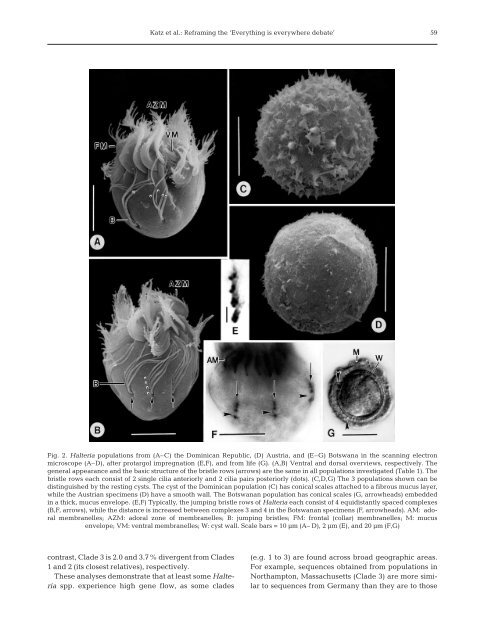Reframing the 'Everything is everywhere'debate: evidence for high ...
Reframing the 'Everything is everywhere'debate: evidence for high ...
Reframing the 'Everything is everywhere'debate: evidence for high ...
Create successful ePaper yourself
Turn your PDF publications into a flip-book with our unique Google optimized e-Paper software.
Katz et al.: <strong>Reframing</strong> <strong>the</strong> ‘Everything <strong>is</strong> everywhere debate’<br />
59<br />
Fig. 2. Halteria populations from (A–C) <strong>the</strong> Dominican Republic, (D) Austria, and (E–G) Botswana in <strong>the</strong> scanning electron<br />
microscope (A–D), after protargol impregnation (E,F), and from life (G). (A,B) Ventral and dorsal overviews, respectively. The<br />
general appearance and <strong>the</strong> basic structure of <strong>the</strong> br<strong>is</strong>tle rows (arrows) are <strong>the</strong> same in all populations investigated (Table 1). The<br />
br<strong>is</strong>tle rows each cons<strong>is</strong>t of 2 single cilia anteriorly and 2 cilia pairs posteriorly (dots). (C,D,G) The 3 populations shown can be<br />
d<strong>is</strong>tingu<strong>is</strong>hed by <strong>the</strong> resting cysts. The cyst of <strong>the</strong> Dominican population (C) has conical scales attached to a fibrous mucus layer,<br />
while <strong>the</strong> Austrian specimens (D) have a smooth wall. The Botswanan population has conical scales (G, arrowheads) embedded<br />
in a thick, mucus envelope. (E,F) Typically, <strong>the</strong> jumping br<strong>is</strong>tle rows of Halteria each cons<strong>is</strong>t of 4 equid<strong>is</strong>tantly spaced complexes<br />
(B,F, arrows), while <strong>the</strong> d<strong>is</strong>tance <strong>is</strong> increased between complexes 3 and 4 in <strong>the</strong> Botswanan specimens (F, arrowheads). AM: adoral<br />
membranelles; AZM: adoral zone of membranelles; B: jumping br<strong>is</strong>tles; FM: frontal (collar) membranelles; M: mucus<br />
envelope; VM: ventral membranelles; W: cyst wall. Scale bars = 10 µm (A– D), 2 µm (E), and 20 µm (F,G)<br />
contrast, Clade 3 <strong>is</strong> 2.0 and 3.7% divergent from Clades<br />
1 and 2 (its closest relatives), respectively.<br />
These analyses demonstrate that at least some Halteria<br />
spp. experience <strong>high</strong> gene flow, as some clades<br />
(e.g. 1 to 3) are found across broad geographic areas.<br />
For example, sequences obtained from populations in<br />
Northampton, Massachusetts (Clade 3) are more similar<br />
to sequences from Germany than <strong>the</strong>y are to those
















